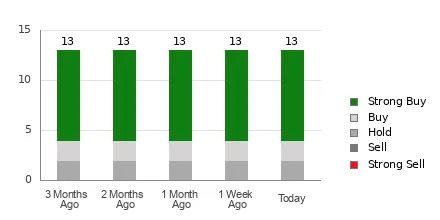
Is It Worth Investing in Coupang (CPNG) Based on Wall Street's Bullish Views?
When deciding whether to buy, sell, or hold a stock, investors often rely on analyst recommendations. Media reports about rating changes by these brokerage-firm-employed (or sell-side) analysts often influence a stock's price, but are they really important?
Before we discuss the reliability of brokerage recommendations and how to use them to your advantage, let's see what these Wall Street heavyweights think about Coupang, Inc. (CPNG).
Coupang currently has an average brokerage recommendation (ABR) of 1.42, on a scale of 1 to 5 (Strong Buy to Strong Sell), calculated based on the actual recommendations (Buy, Hold, Sell, etc.) made by 13 brokerage firms. An ABR of 1.42 approximates between Strong Buy and Buy.
Of the 13 recommendations that derive the current ABR, nine are Strong Buy and two are Buy. Strong Buy and Buy respectively account for 69.2% and 15.4% of all recommendations.
Brokerage Recommendation Trends for CPNG

Check price target & stock forecast for Coupang here>>>
The ABR suggests buying Coupang, but making an investment decision solely on the basis of this information might not be a good idea. According to several studies, brokerage recommendations have little to no success guiding investors to choose stocks with the most potential for price appreciation.
Do you wonder why? As a result of the vested interest of brokerage firms in a stock they cover, their analysts tend to rate it with a strong positive bias. According to our research, brokerage firms assign five "Strong Buy" recommendations for every "Strong Sell" recommendation.
In other words, their interests aren't always aligned with retail investors, rarely indicating where the price of a stock could actually be heading. Therefore, the best use of this information could be validating your own research or an indicator that has proven to be highly successful in predicting a stock's price movement.
Zacks Rank, our proprietary stock rating tool with an impressive externally audited track record, categorizes stocks into five groups, ranging from Zacks Rank #1 (Strong Buy) to Zacks Rank #5 (Strong Sell), and is an effective indicator of a stock's price performance in the near future. Therefore, using the ABR to validate the Zacks Rank could be an efficient way of making a profitable investment decision.
Zacks Rank Should Not Be Confused With ABR
In spite of the fact that Zacks Rank and ABR both appear on a scale from 1 to 5, they are two completely different measures.
Broker recommendations are the sole basis for calculating the ABR, which is typically displayed in decimals (such as 1.28). The Zacks Rank, on the other hand, is a quantitative model designed to harness the power of earnings estimate revisions. It is displayed in whole numbers -- 1 to 5.